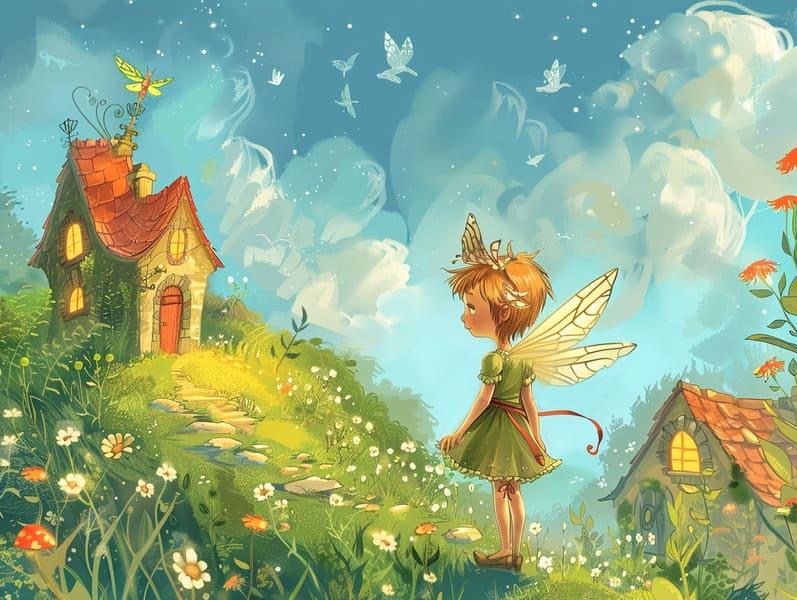
Famous fairy tales have long histories. These stories have been told from one generation to the next centuries before they were ever put on paper. They emerged from a variety of traditions, including African traditions. They were initially conveyed among grown-ups, often carrying themes and messages relevant to the societal norms and beliefs of the time.
The Brothers Grimm, Jacob and Wilhelm Grimm, were among the first to assemble many of these beloved stories. Their anthology, "Grimm's Fairy Stories," included stories like "The True Bride," "Hansel and Grethel," and "Snow-White and Rose-Red," which have since become hallmarks in the world of iconic fairy tales. Similarly, Hans Christian Andersen's fantastical stories, such as "The Mermaid," and "The Duckling that Could," have won hearts worldwide, ensuring their place in the pantheon of iconic fairy tales.
Despite their ancient origins, these tales remain as impactful as ever, especially as bedtime stories for kids. These charming stories are now available in numerous formats, including vividly illustrated books, fantastical animations, and web-based fairy tales.
Their persistent charm can be ascribed to several delightful features:
Crucial Morals: Ancient fairy tales often teach important moral lessons. Narratives like "The Tale of the Boy Who Cried Wolf" teach the virtue of honesty, while "The Story of the Tortoise and the Hare" stress the traits of resolve and modesty. These stories offer children clear distinctions between ethical and unethical, forming their moral compass in a kind yet lasting way.
Compassion and Knowledge: Classic fairy tales frequently feature protagonists facing difficulties and adversities, inciting children to connect with their struggles and champion their triumphs. For instance, "Beauty and Her Beast" shows us the necessity of looking beyond appearances to realize the real character of a being, enhancing insight and knowledge.
Cultural Recognition: Many traditional fairy tales are imbued with the cultural contexts from which they sprang. Learning from these fairy tales can provide enlightening views into different customs, strengthening a sense of cultural awareness and acknowledgment.
Imagination and Creativity: The enchanted elements in ancient fairy tales—fairy godmothers—trigger children’s fantasies. These fairy tales bring readers to fantastical realms, promoting fantasy-filled thoughts and a sense of awe that persists a lifetime.
Old fairy tales are not only captivating but also illuminating. They work as alluring tools in promoting various brain and heart skills in young ones. When timeless fairy tales are voiced, they promote speech development by presenting new linguistic elements and sophisticated sentence structures. This practice also enhances auditory skills and concentration, as young ones keep up with the story, eager to see what happens next.
Furthermore, deliberating the themes and characters of ancient fairy tales can nurture thinking skills and reasoning skills. The young are shown to discover patterns, guess what will happen, and make sense of cause and effect. These debates also promote the young reveal their thoughts and feelings, cultivating their emotional intelligence.
In today’s digital era, the abundance of free fairy tales online has made these fairy tales more attainable than ever. Web platforms and apps share comprehensive collections of traditional fairy tales that can be explored or heard anytime, anywhere. Fairy tales read out loud are particularly favored, supplying an immersive method for little ones to relish these charming tales. Sound books and read-to-me videos move characters and settings to life, often augmented by captivating musical scores and tunes that elevate the narrative experience.
The unending appeal of old fairy tales lies in their ability to adapt to modern society while staying true to their central values. Contemporary retellings of these fairy tales often feature more multicultural figures and modern settings, making them meaningful to today’s audience. However, the basic principles of boldness, kindness, and lawfulness remain unchanged, continuing to appeal to kids of all ages.
Fairy tales also offer a sense of calm and closeness. They present a ordered narrative with a evident beginning, middle, and end, often coming to a close with the resolution of conflicts and the triumph of justice over injustice. This regularity can be consoling for children, delivering a this site sense of steadfastness in an constantly changing world.
Traditional fairy tales continue to spellbind and coach new generations, maintaining their charm and importance in modern society. As children's bedtime stories, they share a perfect blend of charm and understanding, encouraging moral values, empathy, and creativity. The existence of internet fairy tales and the favor of fairy tales narrated affirm that these classic tales remain available to new generations.
By maintaining and divulging these fairy tales, we continue to commemorate the rich tapestry of narrative artistry and cultural heritage. Whether you are experiencing a vibrantly illustrated book, perusing a virtual collection, or listening through an voice book, the allure of Grimm's fairy tales is always within reach. These stories convey of the persistent impact of stories and its ability to bring us together across time and space.
If you are browsing a colorful picture book, accessing a internet collection, or listening on an audio story, the beauty of classic fairy tales is always within reach.
These stories demonstrate of the eternal spell of stories and its ability to gather us across epochs and places, casting a charm that delights and instructs alike.